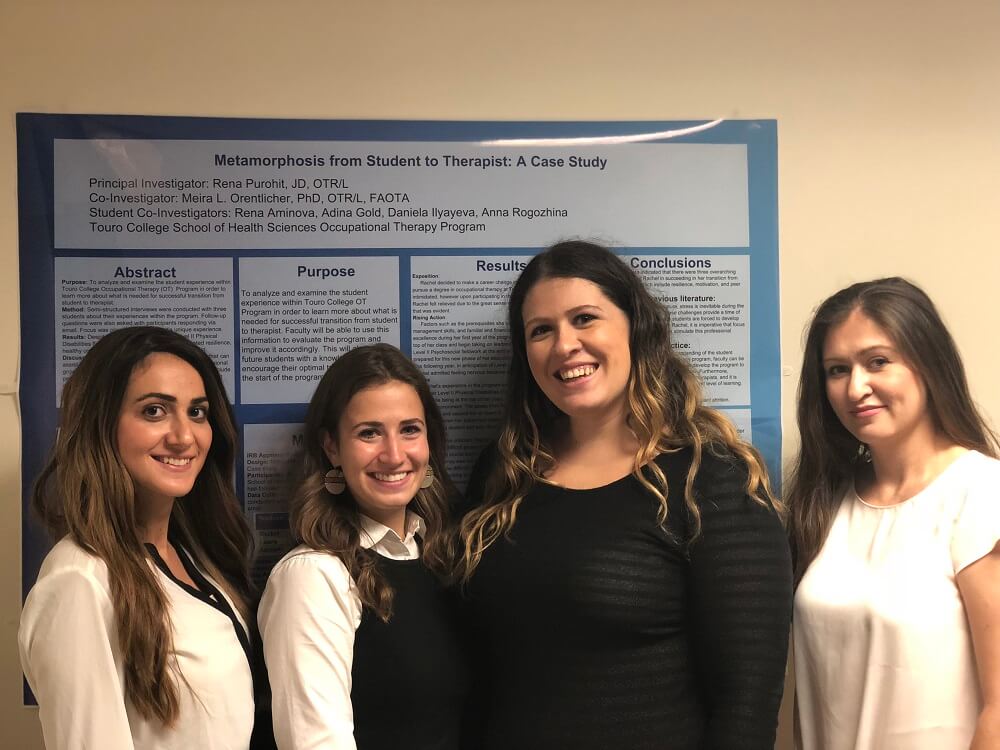Is the Assumption Correct?
Class of 2019 Occupational Therapy Students Deliver Final Presentations

For their final research project, one group of School of Health Sciences occupational therapy students studied their fellow student. Entitled, “Metamorphosis from Student to Therapist: A Case Study,” the project looked at a promising occupational therapy student and the challenges she faced on her way to graduation.
“We focused on how she overcame her problems through perseverance, peer support and her own maturation,” said OT student and group member Rena Aminova. The study, led by Dr. Rena Purohit, also had a personal dimension for Aminova. “These are all qualities I need to learn how to use to succeed in my own studies,” she explained.
Aminova’s group, along with six other groups composed of third-year students at the School of Health Sciences Occupational Therapy program, delivered their final research presentations at Touro College’s offices in Midtown Manhattan on October 11. To graduate, each occupational therapy student is required to complete a final research project under the guidance of a faculty mentor. The presentations were attended by second-year OT students as well as Dr. Nadja Graff, Vice President of Touro College’s Division of Graduate Studies and Dr. Stanley Boylan, Vice President of Touro College’s Undergraduate Studies and Dean of Faculties.
There are several goals for the research project, explained Dr. Meira Orentlicher, SHS associate director of research and scholarship and occupational therapy professor. The project teaches students how to perform valid research along with stressing how important research is for the OT profession. Frequently, the final research projects culminate in published papers in OT journals and students present their findings at OT conferences.
Dr. Orentlicher said she was especially impressed with this year’s group of researchers.
“Many of the projects have been underway for some time," said Dr. Orentlicher. "While the students might have been green in doing research they were able to focus on what the faculty members needed from them.” Dr. Orentlicher also spoke about the unique nature of OT research that the students were involved in. “Being a successful OT researcher means using both hard data, like quantitative studies, and so-called soft data, qualitative measures like case studies and surveys,” she explained. “Both are valid in our field.”
The projects covered a wide swath of issues inside the OT field. Topics ranged from whether isolated attention training was effective in helping individuals in cognitive and motor tasks; the behavioral risk factors associated with diabetes in the Orthodox Jewish community; and age-friendliness in the OT profession.
Dr. Orentlicher said her particular favorite moment of the presentations was one group’s admission that they had made an error in recruitment for their study. “The fact that they stood up and took responsibility really showed me how much they learned,” said Dr. Orentlicher.
“It’s great that OT as a profession really focuses on the research aspect of intervention,” said student Paul Gallardo, whose group looked at how OT students viewed time according to the Zimbardo Time Perspective Inventory.
Student Teryn Bieler, whose group researched the difficulties six novice OT professors faced as they transitioned from being a clinician to a teaching role, also took a personal lesson from her research.
“Most of the people we interviewed said they were surprised by how much more there was to academia than curriculum and presenting to class,” said Bieler. “I’ve gained respect for all my teachers and all they do. I’ve learned about the qualities that are required for both a clinician and an academic professor.”
One group, led by SHS Associate Dean Dr. Rivka Molinsky, sought to determine if there was validity to a popular conception in New York’s healthcare world.
“The prevalent perceived reality is that Hispanic and Orthodox Jewish individuals have higher rates of diabetes,” explained Dr. Molinsky, adding that many doctors and nurses she encountered agreed with it. “We were trying to figure out if the assumption is correct and if the population is at risk.”
The findings were inconclusive, but student Elina Priveya said she learned something from the endeavor nonetheless.
“Because of how much research we did, I feel like I’ll be more knowledgeable as an OT, especially if I end up working with people who have diabetes or who are at risk of it,” said Priveya.

